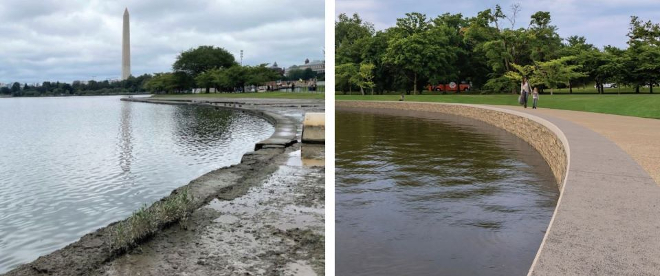WASHINGTON – The National Park Service is preparing for a three-year, $113 million rehabilitation of the seawalls around the Tidal Basin and along the Potomac River through West Potomac Park funded by the Great American Outdoors Act Legacy Restoration Fund. This critical investment will ensure the park is able to protect some of the nation’s most iconic memorials and the Japanese flowering cherry trees from the immediate threats of failing infrastructure and rising sea levels for the next 100 years.
Initial construction activity will begin in late spring and early summer 2024 and will focus on establishing a construction staging area in West Potomac Park and site preparation around the Tidal Basin. Once the staging is complete, construction will occur in two phases, first around the Tidal Basin, followed by the Potomac River work in West Potomac Park.
There will be no construction activity in 2024 that affects visitors to the National Cherry Blossom Festival, and the trail around the Tidal Basin will remain open through the duration of the work, although temporary pedestrian detours will be constructed in some areas. The seawall restoration is projected for completion in 2027.
Site preparation at the Tidal Basin beginning in late May 2024 will require the removal of 158 of the nearly 3,700 Japanese flowering cherry trees on the National Mall. Around the Tidal Basin, the trees will be removed between the Thomas Jefferson Memorial and Franklin Delano Roosevelt Memorial. Tree locations and topography were considered in the construction planning, and every effort was made to minimize the number of trees that must be removed. In all, approximately 300 trees are scheduled for removal in the construction zones. When the project is completed, 455 trees (including 274 cherry trees) will be replanted in the area.
Age, rising sea levels and poor drainage have taken a toll on the Tidal Basin and West Potomac Park seawalls. Portions of the seawalls have settled as much as five feet since their initial construction from the late 1800s to the early 1900s. As a result of the settling and sea level rise, water flows over portions of the seawalls twice a day during normal tidal conditions. Despite various repairs over the decades, the seawalls are no longer structurally sound and threaten visitor safety and the historic setting, including the cherry trees around the Tidal Basin.
The repair of the Tidal Basin and West Potomac Park seawalls is part of nearly $500 million in planned infrastructure improvements at the National Mall prior to the 250th anniversary of American independence in 2026. The repairs will include:
- removing and reconstructing the existing stone masonry seawalls to include a pile-supported platform foundation that will prevent the seawalls from settling, and support height extensions of the walls if needed due to future rising sea levels or increasing storm surge,
- salvaging and reusing stones from the historic wall in the rehabilitated seawalls, when possible,
- repairing, or replacing, and widening walkways around the Tidal Basin to provide smoother, more accessible connections to other pathways, and
- regrading landscaping adjacent to the seawalls as necessary to provide proper drainage.
The Great American Outdoors Act is part of a concerted national effort to address the extensive maintenance backlog in America’s national parks. Supported by revenue from energy development, the fund provides the National Park Service with up to $1.3 billion per year for five years to make significant enhancements in national parks that will ensure their preservation and provide opportunities for recreation, education, and enjoyment for current and future visitors.



